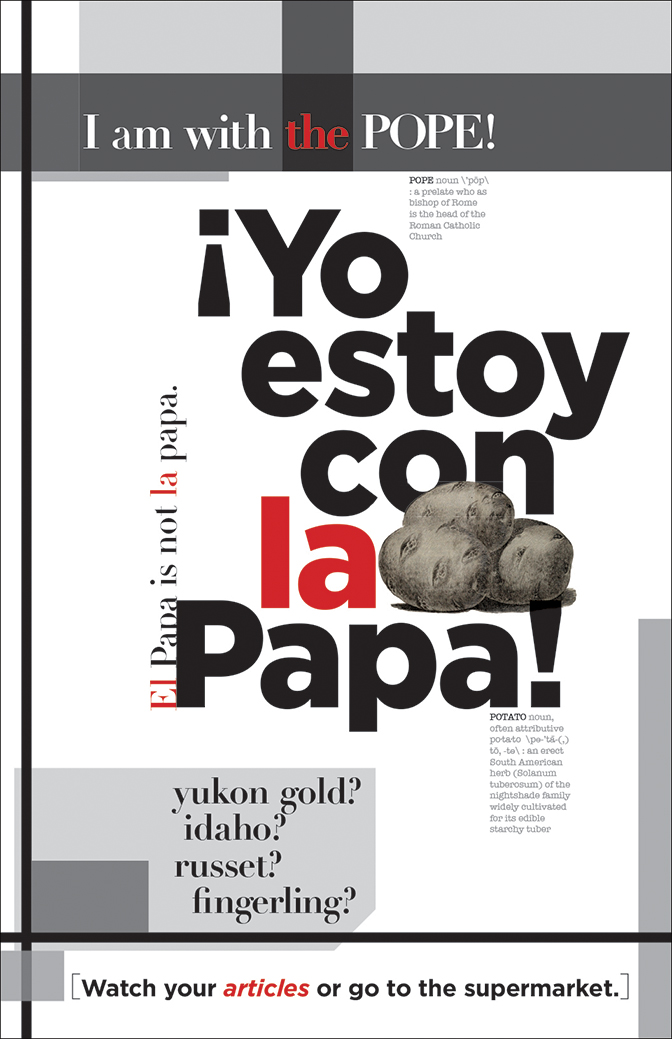By Rocío Villaseñor
Spanish has become the second most used language in the United States.
According to a Pew Research Center report from September 2017, “the Latino population in the United States has reached nearly 58 million in 2016″ and more than 37 million speak Spanish. However, not all Spanish speakers speak or write it correctly, and the media doesn’t help to improve the situation because they often do not respect the accent marks, or omit the tilde on the eñe letter.
The graphic exhibit ‘No Literal’ by Peruvian journalist and designer Elio Leturia tries to illustrate the situation through 12 posters.
These compositions portray different examples, including incorrect translation from English into Spanish. One is mistakenly translating “María is embarrassed,” to “María está embarazada” when it should have been, “María está avergonzada.” “Embarazada” means “pregnant.”
Another common mistake is to ignore adding the ~ on the n (eñe.) The Spanish language has 27 letters, while English 26. The letter “ñ” has a special sound and the tilde is an integral part of it. An example is “caña” (sugar cane, or fishing rod) which means something different than “cana” (gray hair.)
The accents on the vowels are also extremely important and should not be omitted because they alter the meaning of the words. An example is “papa” (potato) and “papá” (dad.) “Who wants his father to become a tuber?,” asks Elio Leturia, the artist responsible for these posters.
Additionally, Spanish is a language that presents gender as opposed to English. Nouns, adjectives, articles are masculine, feminine and neutral in both singular and plural forms. An example is saying “el amigo” which means the male friend and “la amiga,” the female friend.

A poster says “Se infectó con la cólera” (He got infected with anger) when it should have said, “Se infectó con el cólera” (He got infected with cholera.) “Suddenly the rage became a contagious disease”! notes Leturia.
Instituto Cervantes Cultural Activities Coordinator Teresa Hernando Rojo, said that speaking and understanding Spanish [correctly] is very important because people who see or read information from the media can be offended or confused. “The correct use of the Spanish language is a necessity and urgency,” she said.
Leturia’s exhibit is a provocative and fun reminder to mind your tildes and acentos and make sure you are saying what you really want to say! En español, it really matters.
‘No Literal’ will remain open at the Instituto Cervantes of Chicago until February 22. The Chicago Chapter of the Fulbright Association is hosting a closing reception that evening. RSVP for the closing event here
—
Rocío Villaseñor is a journalism graduate student at Columbia College Chicago.
The original Spanish-language version of the article follows.
La versión original del artículo, en español, a continuación
—
¿Dónde están las tildes y los acentos?
El lenguaje español se ha convertido en el segundo idioma más usado en los Estados Unidos.
De acuerdo a un reporte del Centro de Investigación Pew de setiembre del 2017, “la población latina ha casi llegado a 58 millones en 2016” en los Estados Unidos y más de 37 millones hablan español. Sin embargo, no todos los hispanoparlantes lo hablan o lo escriben correctamente, y los medios de comunicación no han ayudado a mejorar esta situación pues no respetan los acentos, y muchos no utilizan la tilde sobre las eñes.
La exposición grafica ‘No Literal’ del periodista y diseñador peruano Elio Leturia trata de ejemplificar la situación a través de 12 afiches.
Esta variedad de composiciones artísticas muestran diferentes casos, entre ellos, de traducción incorrecta de inglés al español. Un ejemplo es “María está embarazada”, al tratar de traducir “María is embarrassed” cuando lo que debería decir correctamente es “María está avergonzada”.
Otro error común es ignorar agregar la ~ sobre la n. El idioma español tiene 27 letras, mientras el inglés 26. La letra “ñ” tiene un sonido especial y la tilde (o virgulilla) es una parte integral de la misma. Un ejemplo es ‘caña’ (caña de azúcar o caña de pescar) que significa algo diferente que ‘cana’ (cabello blanco).
Los acentos sobre las vocales también son extremadamente importantes y no deben omitirse porque alteran el significado de las palabras. Un ejemplo es “papá” y “papa”. “¿Quién quiere que su padre se convierta en un tubérculo?”, pregunta Elio Leturia, el artista responsable de estos afiches.

Adicionalmente, el español es un lenguaje que presenta género a diferencia del idioma inglés. Los sustantivos, los adjetivos, los artículos son masculinos, femeninos y neutrales tanto en formas singulares como plurales. Un ejemplo es decir ‘el amigo’ que significa el amigo hombre y ‘la amiga’, la amiga mujer.
Un afiche dice “Se infectó con la cólera” cuando debería haber dicho, “Se infectó con el cólera”. “De repente la rabia se convirtió en una enfermedad contagiosa”, añade Leturia, quien piensa que al añadir humor la muestra se hace más divertida y provocadora.
Teresa Hernando Rojo, coordinadora de actividades culturales del Instituto Cervantes de Chicago, comenta que hablar y entender el español es muy importante porque la gente que ve o lee los medios de comunicación se puede ofender o confundir. “El buen uso del lenguaje español es una necesidad y urgencia”, dijo.
La muestra de Leturia es un recordatorio divertido y provocador sobre la importancia de utilizar las tildes y los acentos para estar seguro de lo que uno quiera decir es correcto. En el idioma español, estos signos son necesarios.
—
‘No Literal” permanecerá abierta en el Instituto Cervantes hasta el 22 de febrero. La Asociación Fulbright de Chicago está ofreciendo una recepción de clausura esa noche. Para asistir al evento reserve aquí.
Rocío Villaseñor es estudiante del programa de maestría en periodismo en Columbia College Chicago.